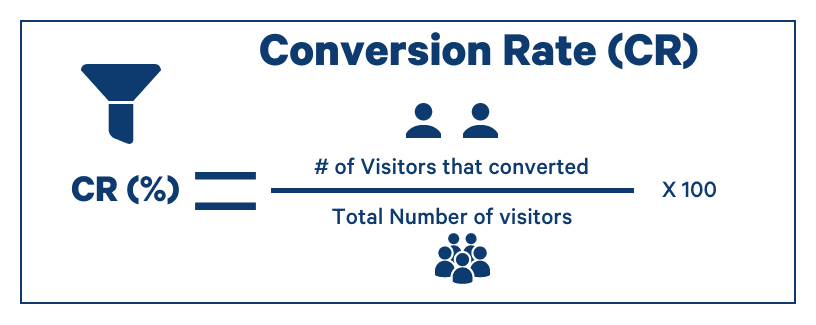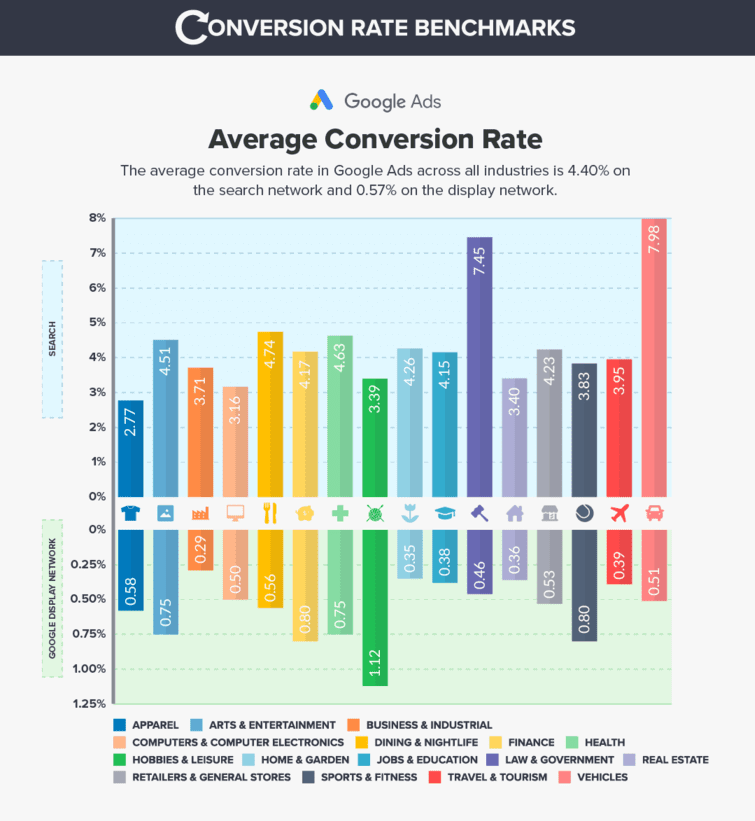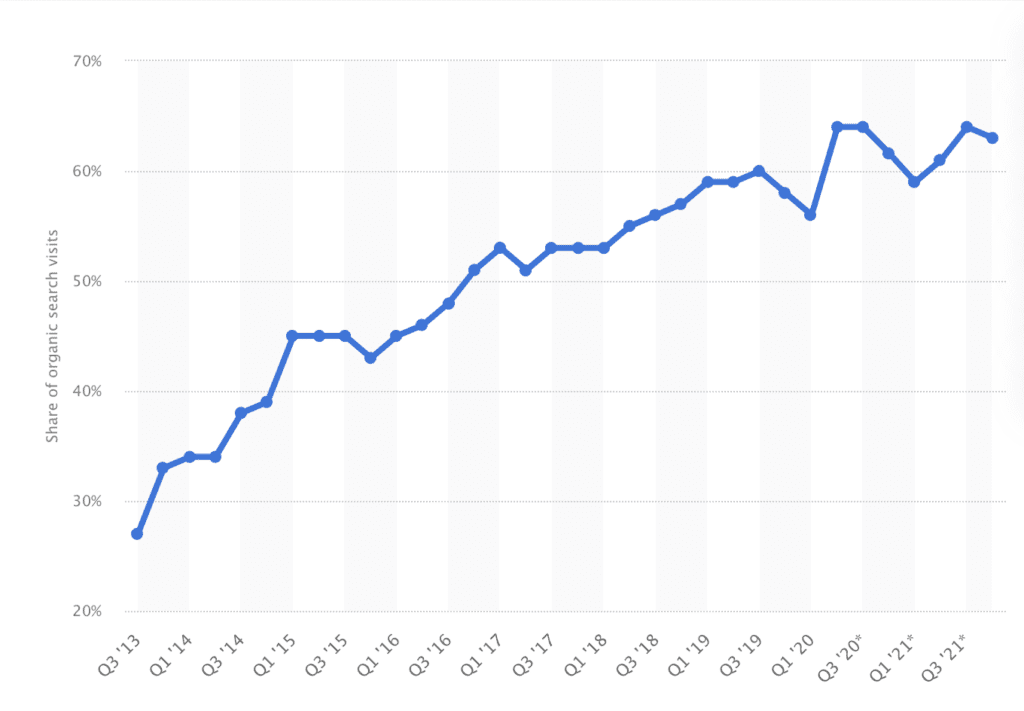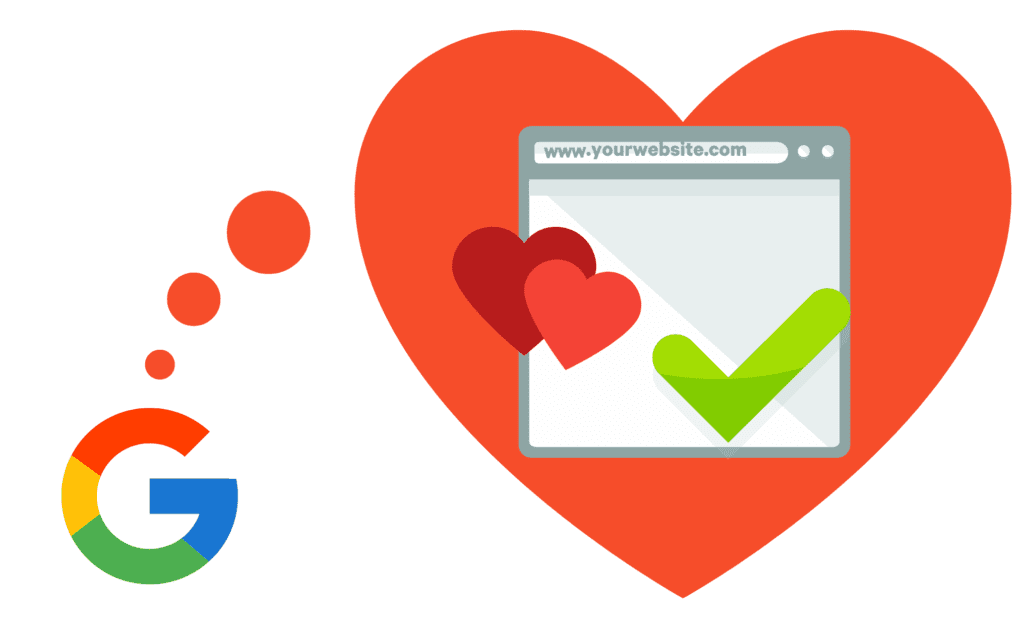What is the average conversion rate for a website?


What Is the Average Conversion Rate for a Website in 2024?
Gotcha! You thought I would have that info.
As 2024 is only halfway through, there's no research on the average conversion rate in 2024 – obviously.
However, we can lean on some previous research and the first quarter of 2024.
According to Statista, the average e-commerce conversion rate across all researched verticals was 1.6% in the first quarter. General apparel online stores went for the win with 2% and luxury handbags had to settle for 0.3%.
So that's the news! Other than that, we have to settle for older numbers. According to WordStream, the average landing page conversion rate across industries is 2.35%.
According to Unbounce, the median conversion rate is 4.3% across all industries.
As these examples show, the average conversion rate is tied to your industry, but also conversion goal.
(Not to mention the ambiguity of the statistics – few organizations are transparent about where their statistics come from and when they were researched.)
Let's dig deeper.
What Is a Conversion?
Conversion is basically the holy grail of digital marketing.
However, it can mean a lot of things. When comparing your conversions with someone else's, it's important to make sure you are, in fact, comparing the same thing.
Types of Conversions
Macro Conversions
Macro conversions are the primary goals of your digital marketing efforts. These typically include:
- Purchases: When a user buys a product or service from your website.
- Form Submissions: When a user fills out and submits a contact or lead generation form.
- Sign-Ups: When a user registers for an account, newsletter, or event.
Micro Conversions
Micro conversions are smaller, intermediary steps that lead to macro conversions. Examples include:
- Adding to Cart: When a user adds a product to their shopping cart.
- Clicking a Call-to-Action (CTA): When a user clicks on a CTA button, such as "Learn More" or "Download Now."
- Engaging with Content: When a user reads a blog post, watches a video, or engages with other content on your site.
- Submitting a Form: When a potential customer fills out and submits a lead generation form or contact request form.
Improving your average conversion rates is vital for enhancing your ROI and making the most of your online marketing budget. After all, if you aren’t turning your web visitors into buyers (or action-takers) at an optimum rate, why have a business website in the first place?
Conversion rate optimization allows you to take advantage of every penny of your PPC spend by identifying that sweet spot that persuades a good number of your visitors to take action.
Optimizing them to the fullest is the utopian goal for every marketer on the web. But, if you have been in the world of digital advertisement for a while, you already know only a few achieve their conversion targets.
Then again, what’s conversion rate? What’s the average conversion rate? What conversion rate should you target for your website? Let’s answer these questions.
What Is a Conversion Rate?
Understanding average conversion rates starts by understanding what a conversion rate is.
For any business, the conversion rate connotes turning your potential clients into buying customers. For site owners, a conversion rate refers to the percentage of site visitors who take the desired action.
The archetypal example of this is the percentage of site visitors who actually buy, order, or book something through the site.

You can calculate your conversion rate by using the formula: number of visitors that converted divided by the total number of visitors. Then multiply this by one hundred to get the percentage.
For instance, if your business website is visited by 200,000 people during June, and of those visitors, 5000 people bought something from the website, your conversion rate would be 2.5% (5000/200,000x100).
| Website visitors in a month | Number of purchases | Conversion rate (%) |
| 200.000 | 5000 | 2,5 |
| 150.000 | 2000 | 1,3 |
| 250.000 | 6000 | 2,4 |
In the world of business, however, conversion rates aren’t about the customers alone. The definition is somewhat extended to include any key performance indicator (KPI) that are essential for your business model.
In addition to only measuring number of purchases, you can track:
- visitors frequenting the site for a number of times,
- spending a certain amount of time on the site,
- downloading an application,
- downloading and actually using the app,
- upgrading from one level to another,
- subscribing (paid or free), and
- becoming a registered user,
- etc.
Basically, this entails any other action that you may want users on your site to do. Depending on your target audience, even ‘micro-conversions’ such as simply watching a video or clicking a link can count.
What’s the Average Conversion Rate?
Recent research by World Stream indicates that
- the average landing page conversion rate is about 2.35% across industries.
- Yet, there are high performing businesses at the top 25% that convert more than 5.31% or higher
When it comes to Google Ads, World Stream reports that the average conversion rate is 4.40% on search networks, while significantly lower at 0.57% on display networks.
The main difference between display and search Google ads is that the display ads are basically ‘push’ advertising while search ads are ‘pull’ advertising. Display networks work as demand generators whereby your ads create awareness, while search networks work as demand harvesters and your ads here grab intent.
To put it even shorter:
- Search ads are on top of SERP and indicated with the "ad" tag
- Display ads are targeted ads that can appear anywhere else but SERPs
Does this mean that display ads are a complete waste of money? Absolutely not! It is vital to create advertisements that will drive conversions, such as in search networks, but we should never underestimate the power of brand awareness.
Display ads generate demand by creating awareness—no one searches for a brand they don’t know.
According to World Stream, the average industry-wide conversion rates vary significantly in both search and display networks. For instance, for vehicles, the conversion rate is at a high 7.89% (search networks) and 0.51% for display networks.

Average Conversion Rate by Industry
In digital marketing, it's always best to compare your numbers against other in your industry. In addition, you should keep in mind that the numbers are different in paid search ads and in the display network.
To prove my point, have a look at these numbers:
- In tourism and travel, the average is 3.95% (Search Network) and 0.39% (Display Network)
- Real estate 3.40% (SN) and 0.36% (DN)
- law and government 7.45% (SN) and 0.46% (DN)
- retail and general stores 4.23% (SN) and 0.53% (DN)
- finance 4.17% (SN) and 0.80% (DN)
As you can see, there's plenty variation between different industries. The average eCommerce website conversion rate is at 2.63% in the US where the global website conversion rate is at 4.31%.
Website Conversion Rate Benchmark

Amongst the most common industries, apparel performs poorly at 2.77% (SN) and 0.58% (DN), compared to the best vehicles.
But this figures evidence that average conversion rates across sectors vary considerably, and you shouldn’t try to make the mistake of comparing your business to the average across industries. This may give you the impression you are doing well (or poorly), but in reality, you are not.
What Conversion Rate Should You Target for Your Website?
Again this will vary depending on your business and industry benchmarks.
If you’re already hitting 3%, 5%, or even 10%, you may already be doing great. Such conversion rates indicate that you are already in business since you are getting your customers to act and tapping those CTAs.
But what is a good conversion rate? What should you target for your site? As mentioned earlier, the average website conversion rate across industries is 2.35%, yet the top 25% are converting 5.31% or higher.
Ideally, you want to target even higher than the top 25% and go for the top 10%. There are landing pages that are hitting a conversion rate of nearly 12% or higher.
Again, if you are currently at 3%, the conventional wisdom will tell you that you’re already doing great. If you’re sitting here, a jump to 5% will seem like an enormous jump. But, you’ll still be stuck around the industry’s average.
The best is to aim for more than 10%, aspiring to beat your industry’s average conversion rate by 2x, 3x, or even 5x!
Conversion Goal in Laymen Terms
More important than an individual conversion rate is to focus on the big picture. Ask yourself:
- What's my average order value?
- Am I reaching my target audience?
- Where's my traffic coming from, from mobile devices or desktop browsers?
- How many unique visitors do I have?
- How many turn into paying customers?
Only after answering these questions you can calculate conversion rate for each key area that you want to track in the first place. When you aim to boost conversions, you need to keep in mind that it can quickly become a vanity metric.
"Hey, Google Analytics finally says that my website conversion rates are on the rise!" and you take look at the total sales you're making, but the numbers have actually gone down.
At the end of the day, by blindly focusing on website conversion rates, you can be very misguided in terms of what actually makes you more money.
Variables Impacting Conversion Rates
When you've compared yourself against others in your industry, it's good to remember that this isn't the only factor affecting conversions.
Quite understandably, an eCommerce store selling knick-knacks at a low-price point will have higher conversions than someone selling expensive luxury products. Not to mention if your product has a very tiny target audience.
Factors to Consider
- Product type
- Traffic source (Google, Facebook, IG, paid search vs. display ads)
- Size of target audience
- Length of sales cycle
- Location
- Average order value
- Device used (desktop, tablet, mobile)
Benefits of Optimizing Conversion Rates
By paying attention to factors that impact your conversion rates, you can achieve at least the following benefits.
Get More Qualified Leads
By critically evaluating how you make people to convert, you're also enhancing the quality of the leads you get. A win-win!
Start using these 6 lead generation forms that are proven to improve your conversions.
Reach Those Mobile Users
According to Statista, over half of the people are now using mobile instead of desktop to search.

Have you optimized your website for those mobile users yet? Start doing that now to gain offer the smoothest possible experience to all those mobile users.
This is an easy way to increase conversions, if you haven't paid much attention to this yet.
More Organic Traffic with Social Proof
If you use social proof as a way to improve conversion rates, you can improve your SEO at the same time. Search engines simply love testimonials and reviews.

FAQ
What is a good website conversion rate?
A good conversion rate is above 10%. The bigger the rate, the more profitable your business is!
The average website conversion rate across industries is 2.35%. However, the top 25% are converting 5.31% or higher.
What is the average for landing page conversions?
An average conversion for landing page is at 2.35%.